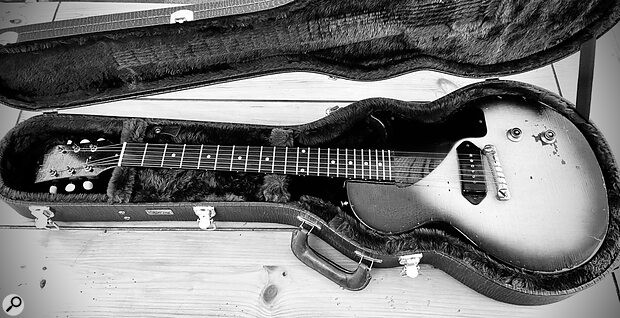As a working guitarist immersed in both session work and music education, I often encounter the question: “What’s your go-to guitar?” Truthfully, for professional engagements, each guitar serves a purpose dictated by the specific musical context. However, when the work is done and I’m playing purely for personal enjoyment, the answer shifts unequivocally. For me, that guitar, without hesitation, is my Gibson Les Paul Junior.
My initial encounter with the Les Paul Junior’s distinctive voice remains vivid. It was through a classic rock compilation, a track by Mountain featuring the legendary Leslie West. The raw, visceral tone was unlike anything I’d heard before, sparking an immediate quest to uncover the instrument behind that sound. Serendipitously, a guitar magazine soon after published an article spotlighting West’s mastery of the Les Paul Junior. That was the moment of revelation. This was an instrument I needed to experience firsthand. Acquiring one took time (a story perhaps for another occasion), but when I finally did, it more than lived up to the initial fascination.
 Leslie West Les Paul Junior
Leslie West Les Paul Junior
Is the Les Paul Junior the epitome of guitar perfection? Objectively, no, especially if such a concept even exists. Its wraparound bridge is not universally lauded for precision. Some neck profiles have been likened to wielding a baseball bat, and it sports only a single pickup. Yet, it’s precisely this Spartan design that fuels my affection. This guitar offers no shortcuts; it demands more from me as a player than any other instrument I’ve owned. It unflinchingly reveals every nuance, every subtlety – or lack thereof – in my playing. It’s easy to understand why Leslie West famously described these straightforward instruments as akin to “a tree with a microphone.” This raw, unadulterated quality is central to the Les Paul Junior’s charm.
Granted, in high-gain scenarios, the inherent hum of the single P90 pickup has occasionally drawn the ire of sound engineers and producers. But even this characteristic hum, sometimes bordering on foreground noise, is, to me, part of its inherent appeal. No noiseless pickups for me; I welcome the hum. It signals that things are about to get interesting, a sonic promise of the untamed energy the Les Paul Junior is capable of unleashing. This raw sonic signature is a key element in the Les Paul Junior’s enduring legacy.
My enthusiasm for these guitars is far from solitary. A quick online search reveals a pantheon of guitar luminaries who have harnessed the Les Paul Junior’s unique character. Steve Howe, Gary Moore, Keith Urban, Ritchie Sambora, Keith Richards, and Phil X are just a few examples of virtuosos who have wrung incredible performances from this humble instrument. Intriguingly, photos even exist of a young Eddie Van Halen wielding a Junior, reportedly a favored choice during Van Halen’s formative years playing Californian house parties in the mid-70s. The Les Paul Junior’s versatility is evident in its adoption across diverse genres and playing styles.
Throughout my career, I’ve explored a wide spectrum of guitars, each excelling in different domains. Yet, when fatigue sets in, or when the spark of guitaristic passion dims, it’s my Les Paul Junior that I reach for to reignite that flame. In a world saturated with perhaps more conventionally prestigious guitar options, my deep connection to this seemingly unrefined, underdog instrument might appear paradoxical. But perhaps, therein lies the very essence of its appeal. The Les Paul Junior is a testament to the idea that sometimes, the most direct and uncomplicated path is the one that leads to the most authentic and inspiring musical expression.

